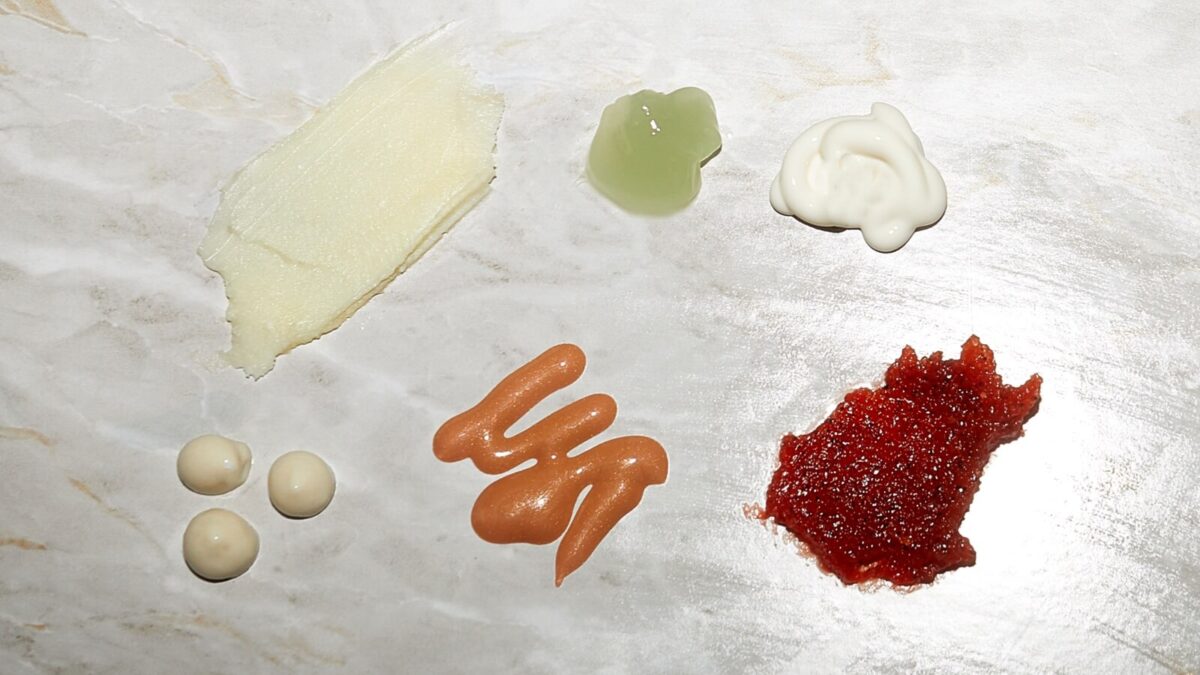When it comes to skincare, it’s easy to feel overwhelmed. Between product types (from oils and serums, to cleansers and moisturisers) through to skin types (you could be dry, oily, sensitive, or combination) getting to grips with basic skincare knowledge is no easy task. And that’s before we’ve even started on ingredients… From niacinamide through to salicylic acid, there are hundreds of buzzy skincare ingredients promising to do everything from clearing breakouts to boosting moisture levels and brightening hyperpigmentation. These days you’ll often find ingredients front and centre of your skincare packaging, but if you’re yet to figure out the benefits of vitamin C versus retinol, or you’re unsure what hyaluronic acid is and how it works, this doesn’t always make things easier…
Luckily for you, we’ve done the hard work and rounded up a bumper list of the most searched for and most popular skincare ingredients, terms, and buzzwords. In this definitive guide you’ll find all the names and terms you’re struggling to decipher from the back of your skincare packaging (and more) – beauty decoding just got a whole lot easier.
Bookmark this page now – and tweet us @beautybay if there’s anything you’d like to see added.
AHAs
Alpha hydroxy acids (AHAs) are chemical exfoliants (like glycolic and lactic acids) which exfoliate the top layers of the skin to remove dead skin cells and stimulate cell renewal. This leaves skin looking brighter and feeling smoother.
Alpha Arbutin
Alpha arbutin is a safe skin-brightening ingredient which helps to fade scars and pigmentation. It works by reducing skin’s pigment production and also slows down the process by which UV light causes pigmentation, so it helps to both prevent and treat.
Antioxidants
Antioxidants are essential to maintaining healthy skin because they help to defend skin against damage from free radicals (which we’re exposed to in most environments). They shield the skin’s surface and work to calm and repair stressed and damaged skin – resulting in skin that feels firmer and looks brighter. Popular antioxidants include vitamins C, A, and E.
Azelaic Acid
Derived from grains, azelaic acid is a gentle exfoliant which helps to reduce clogged pores and smooth skin texture. It also helps to calm redness so is beneficial to those who have rosacea, post-blemish pigmentation, or acne.
Bakuchiol
Often referred to as a natural alternative to retinol, bakuchiol offers similar benefits (smooth texture, reduced pigmentation, improved elasticity) without the negative side effects – redness, dryness, and peeling – and is also suitable to use during pregnancy and breastfeeding.
BHAs
BHA stands for beta hydroxy acid – the most commonly known BHA is salicylic acid. It’s similar to AHAs but is an oil-soluble exfoliating acid which means it can absorb deeper into skin to reduce excess oil, prevent breakouts, and reduce the appearance of pores. It’s especially beneficial for those with oily and congested skin.
Blackheads
A common form of mild acne which looks like an open bump on skin – not to be mistaken with a pore. They form their colour when oil and dead skin cells build up and clog pores then oxidise (as they’re exposed to air) which turns them black.
Caffeine
An anti-inflammatory and antioxidant, caffeine is used in skincare because it energises the skin and protects cells. It’s frequently found in eye creams because of its ability to constrict blood vessels – which reduces swelling and puffiness.
Castor Oil
Castor oil is packed with vitamin E, proteins, and omegas which makes it incredibly moisturising. It’s great for nourishing dry skin, and is also rich in ricinoleic acid, which helps to prevent hair loss and encourage hair growth.
CBD
Derived from cannabis, CBD is free from THC so it won’t get you high. However, it has multiple skin benefits since it’s an antioxidant, an anti-inflammatory, and is extremely moisturising. It encourages skin to produce lipids, the natural fats that maintain skin’s moisture barrier.
Ceramides
If you think of skin as a brick wall, ceramides are basically the cement that holds skin together – they strengthen the skin’s barrier to prevent moisture from escaping in order to improve hydration levels. Our skin naturally produces ceramides, but as we age it reduces production – this weakens the skin’s barrier and leads to loose, dry, and dehydrated skin.
Cica
Rich in amino acids, fatty acids, vitamins, and antioxidants, cica helps to calm inflammation, redness, and irritation, and triggers repair in order to heal damaged skin. It’s derived from a plant found in Asia and Southern Africa, where it’s also known as centella asiatica or ‘tiger grass’.
Copper
In skincare, copper helps to regulate the oil glands to reduce the levels of sebum produced. It’s great for treating oily skin and also has antibacterial and antifungal properties. Copper peptides are a popular skincare ingredient which help to heal and repair skin.
Cystic Acne
One of the more extreme forms of acne, these appear as swollen lumps under the skin, filled with pus that has nowhere to go. They are deep-rooted so don’t always come to a head and sometimes reappear in the same place.
Free Radicals
When skin is exposed to environmental aggressors like pollution and UV rays, it generates free radicals. These are harmful molecules which attach cells and cause long-term damage. They prevent skin’s ability to repair itself, and speed up the appearance of skin aging. They’re best treated with antioxidants like vitamin C.
Glycerin
Glycerin is a moisturising ingredient commonly found in skincare – it’s found in most serums and moisturisers as well as products like cleansers and face masks. Glycerin is a humectant which means it works by drawing moisture into the skin.
Glycolic Acid
A chemical exfoliant also known as an AHA, glycolic acid works by breaking down dead skin cells so that fresh new cells can show through. It’s great for treating dull skin, dryness, and for fading hyperpigmentation.
Hemi-Squalane
Like squalane (see below), hemi-squalane has the same hydrating benefits. It’s made up of smaller molecules which give it a lighter and drier texture which feels watery and is easy to spread and fast to absorb.
Hyaluronic Acid
Hyaluronic acid acts like a magnet to draw moisture into the skin. Each molecule can hold up to 1000 times its weight in water, so it’s ideal for improving skin’s hydration levels.
Hormonal Acne
When papules and cysts appear along your jawline and around your mouth and chin, they’re probably triggered by hormones. Hormones fluctuate throughout our lifetime and during the monthly cycle – they trigger oil production before your period which makes it more likely that pores will clog and spots will form.
Lactic Acid
Like glycolic acid, lactic acid is an AHA which works by removing dead cells from the top layers of the skin. It is a gentler and less irritating alternative to glycolic acid as its molecules are larger and cannot penetrate as deeply. It also helps to draw moisture into the skin so is a great chemical exfoliant to use if you experience dryness.
Millia
These tiny white bumps look like whiteheads but are actually tiny cysts that form when keratin proteins become trapped under the skin with nowhere to go. They’re often found in the eye area where skin is thin and delicate.
Non-Comedogenic
If a product is labelled as ‘non-comedogenic’ it means that it doesn’t contain ingredients that are known to clog pores. This means it’s safe to use if you have oily, combination, or breakout-prone skin.
Niacinamide
Also known as vitamin B3, niacinamide is a great ingredient for any skin type or concern, but is particularly beneficial for skin that needs soothing and balancing. It helps to improve hydration, remove skin texture, and reduce blackheads, breakouts, and redness.
Papules
Caused by growth of acne bacteria on the skin’s surface, papules are tiny, sore red spots that don’t form a head or appear to break through the skin.
Peptides
Peptides are the proteins and molecules that make up the building blocks of skin, and keep it feeling smooth, firm, and bouncy. They send signals to cells which encourages them to produce more collagen (which our bodies loose as we age).
PHAs
PHAs (poly hydroxy acids) work in the same way as AHAs, but they don’t penetrate skin as deeply (because their molecules are much larger). This means they cause less irritation so are ideal for those with sensitive skin or who are new to using acids in their routine.
Prebiotics
Prebiotics are a food source for probiotics (‘good’ bacteria). By feeding and increasing the amount of probiotics, they lead to a stronger skin barrier and improved moisture retention.
Probiotics
The ‘good’ bacteria that lives in our body and is essential to maintaining skin health. Probiotics strengthen skin’s barrier, which helps to soothe irritation, balance oil production, and create a natural shield that prevents dehydration and keeps external aggressors like pollution and bacteria out.
Pustules
When a blackhead or whitehead becomes extremely clogged, the skin swells and a pustule forms. They appear as white dot surrounded by inflamed red skin.
Retinoids
Derived from vitamin A, retinoids increase cell turnover and boosts collagen production. As a result, loose skin is plumped up so lines disappear, and pigmentation is faded so skin appears brighter. Since they stimulate cell turnover in the lower layers of skin and prevents pore clogging, retinoids are also an effective anti-acne ingredient. ‘Retinoid’ is an umbrella term used to describe vitamin A-derived ingredients, which includes retinol, retinoic acid, retinyl esters, and retinaldehyde. Retinol is the most well-known of these since it doesn’t need a prescription to access.
Rosehip Oil
Rich in ingredients like vitamin C, vitamin E, and fatty acids, this naturally occurring oil is known for its ability to heal and regenerate damaged skin. It helps to treat concerns like scarring and fine lines and is even suitable for oily and acne-prone skin.
Salicylic Acid
Salicylic acid is a chemical exfoliant known as a BHA. It is oil-soluble, so unlike AHAs, has the ability to penetrate deep into the layers of the skin. Once there, it dissolves the ‘glue’ that holds cells together in order to remove dead skin cells that clog pores and cause breakouts.
SPF
SPF stands for sun protection factor, and is a measure of how well a sunscreen will protect your skin from UVB rays, which are responsible for sunburn, skin damage, and skin cancer. If your skin would normally burn after 10 minutes in the sun, applying an SPF 30 sunscreen would allow you to stay in the sun without burning for approximately 300 minutes (a factor of 30 times longer). The higher the SPF, the longer you have protection, however experts recommend reapplying sunscreen every two hours.
Squalane
Derived from olives or sugarcane, squalane is a potent source of fatty acids. It hydrates and replenishes skin in order to improve texture and boost moisture levels. Squalane is a great ingredient to use if you don’t like traditional oils – it’s non-comedogenic so won’t clog pores.
Vitamin C
A powerful antioxidant, vitamin C can help to brighten skin, reverse the effects of pollution, fade pigmentation, and prevent early signs of aging. It works by stabilising the free radicals that cause cell damage, and by fixing already damaged cells.
Whiteheads
Whiteheads are caused when pores become clogged with oil and dead skin cells, but don’t turn into blackheads because they are closed at the surface of the skin.

